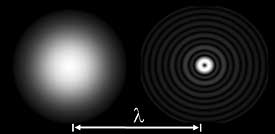Department of Physics
A U-M research team will receive a total of $5 million over the next five years to support an interdisciplinary research project on negative refraction—or bending lightwaves downward.

The group of physicists, electrical engineers, materials scientists, chemists and biologists from five universities will explore methods to produce new negative-refracting synthetic materials. The U-M team, led by physics professor Roberto Merlin, includes Stephen Forrest, vice president for research and physics professor; Rachel Goldman, materials science and engineering professor; and Jinsang Kim, materials science and engineering professor.
The phrase negative refraction describes the property of a material that refracts light in the opposite direction of substances found in nature. Refraction is a well-known phenomenon of light and other electromagnetic radiation. In essence it is observed as light bending as it passes from one medium to another. For example, stick a finger into an aquarium and you will see that the finger in water does not appear to line up with the rest of the hand, because light waves bend as they leave the water and go through the glass side and air before reaching the eye.
Since this negative refraction was first predicted in the 1960s, scientists have debated its existence and have struggled to definitively demonstrate this property. In recent years some of these obstacles have been overcome and scientists, including those at U-M, are developing new methods for creating smart, self-assembling polymers, organic thin films, and semiconductor materials with the desired negative refraction characteristics.
One goal of the research is to create materials that can perform as a lens without needing curved surfaces found in traditional lenses. It has been predicted that materials with negative refraction can image objects that are significantly smaller than the wavelength of light. Although an impossible task for common materials, this may be achieved by the development of negative refraction media, they say.
The negative refraction project is one of 30 nationally to be funded by the Department of Defense (DoD) in fiscal year 2006 under the Multidisciplinary University Research Initiative (MURI) program. In all, $150 million will be spent on the 30 research projects over five years.
The MURI program is designed to address large multidisciplinary topic areas representing exceptional opportunities for future DoD applications and technology options. The awards will provide long-term support for research, graduate students and laboratory instrumentation development that supports specific science and engineering research themes vital to national defense.

